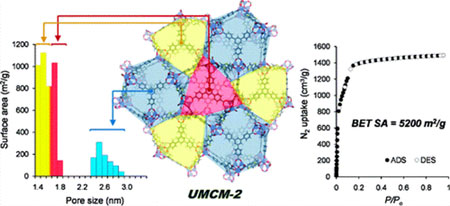| Posted: April 1, 2009 |
New gas storage material: One ounce has surface area of 30 football fields |
|
(Nanowerk News) In a finding that may help speed the production of ultra-clean fuel cell vehicles powered by hydrogen, scientists in Michigan are reporting development of a sponge-like nanomaterial with a record-high surface area for holding gases. Just 1/30th of an ounce of the material has the approximate surface area of a football field. Their study is scheduled for the April 1 issue of the Journal of the American Chemical Society, a weekly publication ("A Porous Coordination Copolymer with over 5000 m2/g BET Surface Area").
|
 |
| A new nanomaterial could help usher in hydrogen fuel cell vehicles. (Image: The American Chemical Society)
|
|
Adam Matzger and colleagues note in the new study that scientists have tried for years to find a material to optimize hydrogen storage in futuristic fuel cell vehicles. Despite identifying several promising materials, researchers have been unable to meet the hydrogen storage goals proposed by the U.S. Department of Energy (DOE) for hydrogen fuel cell vehicles, they state.
|
|
They describe development of a highly-porous nanomaterial with an unprecedented ability to absorb gases that may help meet DOE’s target. Called University of Michigan Crystalline Material-2 (UMCM-2), it consists of zinc oxide nanoclusters — each about 1/50,000 the width of a human hair — linked together by organic materials to generate a robust porous framework. The scientists showed that UMCM-2 has a surface area exceeding 5,000 square meters per gram which is, they say, the highest value ever achieved.
|
|
The study identified the Clinton reactor in Oak Ridge, Tenn., as reactor of origin for this material, by comparing reactor burnup modeling results with measurements of minor Pu isotopes. These results were also supported by a series of historical documents tracking the material's movement from Oak Ridge and the processing at Hanford. “Aside from the historical significance of this find, this work provides the public a rare glimpse at a real-world example of the science behind and power of modern-day nuclear forensics,” the scientists note
|

